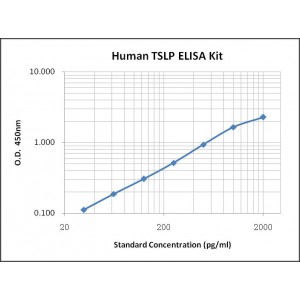More info
Assay Range | 31.2-2,000 pg/mL |
Sensitivity | 10.0 pg/mL |
Specificity | No cross-reaction with other related substances detected |
Size | 96T |
Storage | Store at 2 - 8ºC. Keep reconstituted standard and detection Ab at -20 ºC |
Assay Principle | Sandwich ELISA |
Sample Volume | 100 µL final volume, dilution factor varies on samples |
Sample Type | serum, plasma or cell culture supernatant |
Detection Method | Chromogenic |
Kit Components
1. Recombinant Human TSLP standard: 2 vials
2. One 96-well plate coated with Human TSLP Ab
3. Sample diluent buffer: 12 mL - 1
4. Detection antibody: 130 µL, dilution 1:100
5. Streptavidin-HRP: 130 µL, dilution 1:100
6. Antibody diluent buffer: 12 mL x1
7. Streptavidin-HRP diluent buffer: 12 mL x1
8. TMB developing agent: 10 mL x1
9. Stop solution: 10 mL x1
10. Washing solution (20x): 25 mL x1
Background
Thymic Stromal Lymphopoietin (TSLP) is a glycoprotein belonging to the IL-7 family. The full-length TSLP is a 159 amino acid (aa) precursor composed of a 28 aa signal sequence and a 131 aa mature polypeptide which contains four α-helices, six cysteines, and two potential N-linked glycosylation sites. TSLP is produced primarily by non-hematopoietic cells such as fibroblasts, epithelial cells and different types of stromal or stromal-like cells. Human TSLP shows significant divergence from mouse TSLP. The mature human TSLP shares 37% aa sequence identity with mouse counterpart.
TSLP receptor consists of two subunits: a 48 kDa low-affinity TSLP receptor (TSLP R/CRLF2) and a 70 kDa IL-7 receptor alpha (IL-7 Rα). TSLP R is a type I transmembrane glycoprotein containing a 208 aa extracellular region, a 21 aa transmembrane segment, and a 119 aa cytoplasmic domain. It binds TSLP with low affinity and does not bind IL-7 at all. When complexed to IL-7 Rα, TSLP R activates STAT5 signaling cascade. TSLP is best known for its direct action on subsets of dendritic cells. In thymic medulla, Hassell’s corpuscle epithelium produces TSLP that acts on resident CD11c+ dendritic cells. This induces the expression of B7 family molecules on dendritic cells, which subsequently convert regional CD4+CD25+ autoreactive T cells into CD4+CD25+FOXP3+ regulatory T cells. On TCR-activated T cells, TSLP directly induces T cell proliferation. On monocytes, TSLP is shown to induce the release of multiple chemokines that target CCR4, a receptor associated with the Th2 subset. TSLP-induced Th2 cells are strong producers of IL-13, IL-5, and TNF-α, all of which promote allergic-type inflammations. TSLP exhibits species-specific functions.


